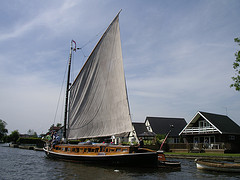Wherry
Wherries were clinker-built with long overhanging bows so that patrons could step ashore dryshod before landing stages were built along the river.
[6] The east coast Wherries from Rush, Skerries and Balbriggan were famously decked, clincher built, and schooner rigged.
"[citation needed] During the eighteenth century rowing competitions for watermen became established on the Thames, and the prize was often a new wherry.
The Sporting Magazine describes an event on 6 August 1795 as "the contest for the annual wherry given by the Proprietors of Vauxhall by six pairs of oars in three heats".
In 1822 Bell's Life reported on a contest on 30 June between eight watermen belonging to the Temple Stairs for "a prize wherry given by the gentlemen of the Inns of Court" and on 31 July "the anniversary of the Grand Aquatic Regatta of the inhabitants of Queenhithe", when "a handsome Wherry" and other prizes were contended for by "six of the free watermen belonging to those stairs".
[11] In North America, particularly in the Penobscot Bay region of the Gulf of Maine, wherries became the preferred boat for the longshore Atlantic salmon fishery.
[12] They are generally long and narrow, with a straight stem, a wineglass stern and usually carvel planked (smooth sides).


